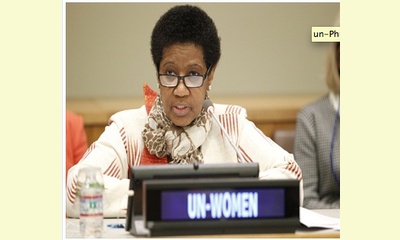|
|
Investing in women peacebuilders is "best value for money": UN Women
an article by Derrick, Mbatha, United Nations News and Media
Spending billions of dollars on projects that often predominantly
benefit men after conflicts has to change. 
Phumzile Mlambo-Ngcuka. UN Photo/Paulo Filgueiras
click on photo to enlarge
That's the message that was delivered by the head of UN Women,
Phumzile Mlambo-Ngcuka at a special event held at UN
Headquarters on Wednesday.
The event on "Women, Everyday Peacebuilders" was organized by
the UN Peacebuilding Commission and UN Women to provide a
forum for women leaders to share their experiences.
In a video message to the event, Mrs. Mlambo-Ngcuka said that in
her first year at the helm of UN Women, she has travelled to areas
affected by conflict and met women who are peacebuilders.
"Investing in women's leadership is peacebuilding's best value for
money. In the aftermath of conflict, billions of dollars are spent on
projects that often predominantly benefit men. By contrast,
grassroots women's leaders often work with very few resources and
this has to change."
Mrs. Mlambo-Ngcuka said women must also have the political space
they need to influence peacemaking and peacebuilding.
She stressed the need for all those involved in security forces and
agencies to ensure the protection of women peacebuilders so that
they continue their critical work.
The head of UN Women said the targeting of women who speak up
for their communities with threats and violence is unacceptable and
must be urgently addressed.
[Thank you to Janet Hudgins, the CPNN reporter for this article.]
|








|
DISCUSSION
Question(s) related to this article:
How can we help make the UN a more effective instrument for peace?,
* * * * *
LATEST READER COMMENT:
The following article by Lyndal Rowlands in the Inter Press Service, suggests that the UN is not making much progress on its commitments for women's equality:
2015 marks anniversaries for two significant commitments made to increasing women’s participation at peace tables.
Yet despite the Beijing Platform for Action and the Security Council Resolution 1325 both committing to increasing women’s participation in peace building 20 and 15 years ago, respectively, there has been very little progress to report.
The latest available statistics show that women made up only 9 per cent of negotiators at peace tables between 1992 and 2011. That the most recent data is from 2011 shows that more work is needed even in basic areas such as data collection and reporting of women’s participation in peace building.
IPS summarises here four reasons we should value women’s participation at the peace table more, based on discussions at the 59th Commission on the Status of Women (CSW) over the past week.
Beijing Platform for Action Section E
Women and Armed Conflict Diagnosis
Strategic objective E.1. Increase the participation of women in conflict resolution at decision-making levels and protect women living in situations of armed and other conflicts or under foreign occupation. Actions to be taken.
Strategic objective E.2. Reduce excessive military expenditures and control the availability of armaments. Actions to be taken.
Strategic objective E.3. Promote non-violent forms of conflict resolution and reduce the incidence of human rights abuse in conflict situations. Actions to be taken.
Strategic objective E.4. . ...more.

|
|









